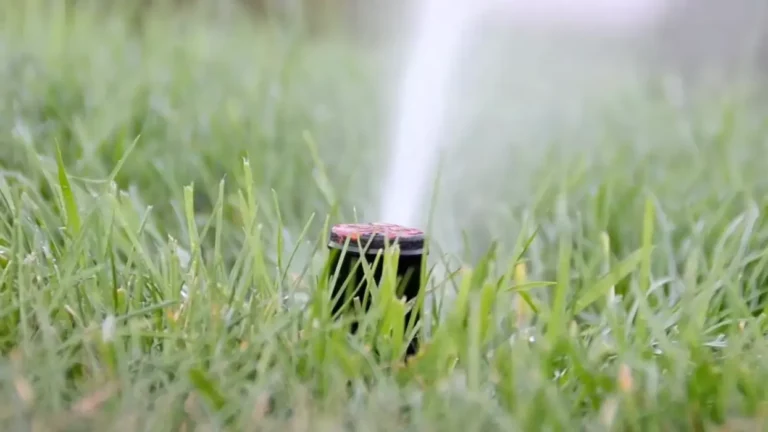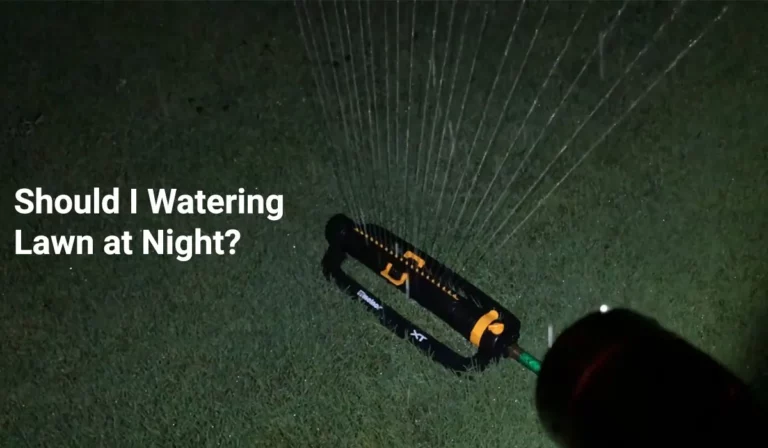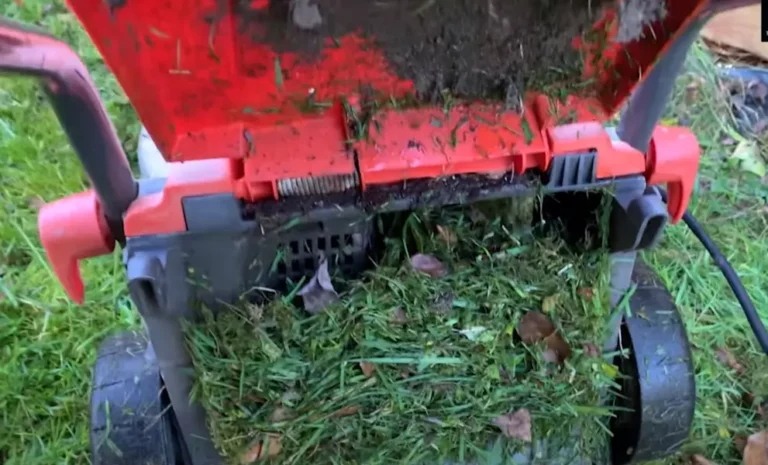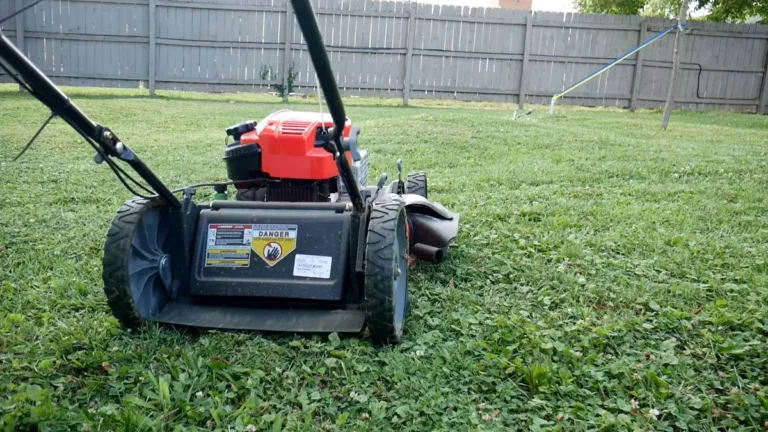How to Fix Mower Deck Digging into Ground?
After mowing, you may notice uneven grass height or some areas with very little grass remaining. This happens when the mower deck keeps digging into the ground.
Common reasons for mower deck digging into ground are deck height, uneven terrain, damaged blades, weight, and mowing technique.
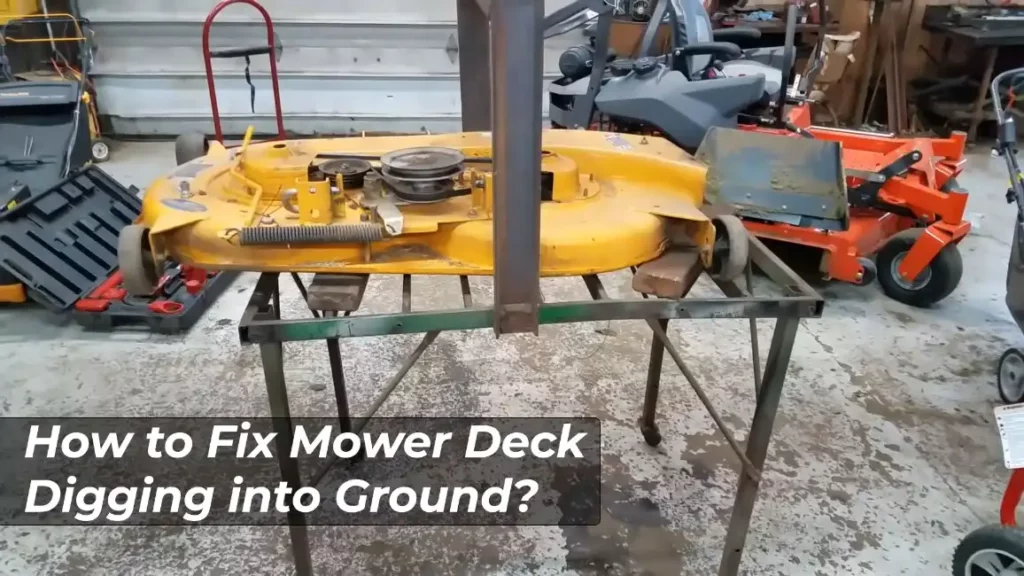
Signs Mower Deck Digging Into Ground
When a mower deck is digging into the ground, there are a few signs you may notice:
- Uneven Cutting
The mower may leave an uneven cut on the grass, with some areas being cut too low or scalped.
- Visible Damage
You may see marks or gouges in the ground where the mower deck has dug into the soil.
- Excessive Vibration
If the mower deck is hitting the ground, you may feel increased vibration in the mower or notice excessive bouncing.
- Stalled or Slowed Progress
The mower may struggle to move forward smoothly if the deck is digging into the ground.
Mower Deck Digging into Ground: Causes & Fixes
Certainly, here are the reasons and potential fixes for a mower deck digging into ground in brief points:
1. Uneven Terrain
The primary reason for a mower deck digging into the ground on uneven terrain is the lack of a floating deck or a suspension system.
Hand-operated mowers typically have a fixed deck height, which means they cannot adjust to changes in the terrain. As a result, the mower deck may dig into the ground when encountering uneven areas, leading to the scalping of the grass and an uneven mowing result.
The Fix
Reduce Mower Speed:
- Slowing down the mower when encountering uneven terrain improves control and minimizes the risk of scalping the grass.
- A slower pace allows for better navigation over bumps and dips.
Level Small Areas:
- Address localized unevenness by adding extra soil to level specific spots.
- This simple fix can create a smoother surface for mowing and reduce the likelihood of the mower deck digging in.
Upgrade to a Mower with a Floating Deck or Suspension:
- Opt for a mower with a floating deck or suspension system.
- These models are engineered to adjust to varying terrain, preventing the deck from digging in and ensuring a smoother, even mow on uneven surfaces.
2. Excessive Speed
High-speed deck digging occurs due to collision forces with uneven terrain or obstacles. When encountering bumps or obstacles, the rotating blades clash with the obstruction, exerting pressure on the deck. This can result in the deck digging into the ground, potentially causing damage.
The fix
To prevent high-speed deck digging, consider these fixes:
Reduce Speed:
Slow down intentionally for better control and stability. Maintain a consistent speed to avoid sudden acceleration or deceleration.
Terrain Awareness:
- Stay alert to the terrain and adjust speed accordingly.
- Slow down when encountering uneven areas, depressions, or obstacles to navigate them smoothly.
Smooth Turns:
Avoid abrupt turns or changes in direction. Gradually maneuver the mower around corners to maintain stability and prevent the deck from digging into the ground.
3. Lower Cutting Height
Low cutting height places mower blades close to the ground, risking them digging in. This leads to uneven cuts and unsightly patches.
It can also result in grass tearing instead of clean cutting, and potentially damage the mower deck, requiring maintenance and repairs.
The Fix
To fix mower deck digging, adjust the cutting height:
Consult the manual:
Check your mower’s manual for recommended cutting heights based on the grass type.
Find the adjustment mechanism:
Locate the lever or mechanism controlling cutting height, usually near the wheels.
Raise the height gradually:
Adjust the lever to lift the blades, maintaining a safe distance from the ground. Avoid setting it too high for even cutting.
Inspect and fine-tune:
Start the mower and ensure the deck no longer digs. Make further adjustments as needed for the desired cutting height.
4. Faulty Mowing Technique
Sometimes, the mowing technique itself can be a reason why the mower deck digs into the ground.
This can occur due to an unbalanced movement of the mower, which shifts the blade excessively on one side, resulting in the deck digging into the ground. Additionally, excessive downforce or pressure on the hand mower can also cause the deck to dig into the ground.
The Fix
To prevent mower deck digging, adjust your mowing technique:
Smooth & Controlled Mowing:
Practice smooth, controlled mowing without abrupt movements.
Avoid Sharp Turns:
On slopes or uneven ground, steer clear of sharp turns or sudden direction changes. Opt for gradual turns and overlap passes for an even cut.
5. Incorrectly Set Anti-Scalping Wheels
When the anti-scalping wheels are not set correctly, it can result in the deck being allowed to lower too much, causing it to dig into the ground.
If the wheels are set too low or not adjusted according to the manufacturer’s recommendations, the deck may go lower than intended, leading to uneven cutting and potential damage to the lawn.
The Fix
To fix deck digging due to incorrectly set anti-scalping wheels:
Consult Manual:
Refer to the user manual for specific instructions on adjusting the anti-scalping wheels.
Locate Mounting Holes:
Identify the holes on the mower deck where the anti-scalping wheels are attached, along with their corresponding heights.
Adjust as per Manual:
Select the correct mounting hole according to your desired cutting height. This prevents the deck from lowering too much, reducing the risk of digging into the ground.
Steps to adjust anti-scalping wheels
- Place a wrench on the mounting bolt of an anti-scalping wheel.
- Use a socket wrench on the mounting nut connected to the same wheel.
- Remove the nut from the mounting bolt. Pull out the bolt from the wheel.
- Repeat steps 2-4 for all anti-scalping wheels.
- With the deck at the desired cutting height, position the anti-scalping wheel in its mounting spot.
- Raise the wheel to be ¼ inch off the ground.
- Align the wheel with the nearest mounting hole, ensuring it remains at least ¼ inch above the ground.
- Insert the bolt through the mount and the wheel, ensuring washers and bearings are correctly placed.
- Reinstall and tighten the nut to the specified torque. Verify that the anti-scalping wheel spins smoothly.
- Measure the distance between the ground and the wheel again.
- Repeat steps 6-12 for all anti-scalping wheels.
6. Dull Blades
Dull blades require more force, leading the deck to push into the ground, resulting in uneven mowing and potential grass damage.
Dull blades tend to shred rather than cleanly cut grass, causing uneven growth and a less appealing lawn.
The Fix
To address the issue of the mower deck digging into the ground due to dull blades, you can follow these steps:
Inspect Blades
Check for dullness, damage, or wear. Replace severely worn or damaged blades.
Sharpen Blades:
Use a file, grinder, or professional sharpener, following manufacturer instructions and maintaining the correct blade angle.
Check Blade Balance:
After sharpening, ensure blades are balanced to prevent further issues
Frequently Asked Questions [FAQs]
Why is my mower deck digging into the ground?
There can be several reasons why your mower deck is digging into the ground. Some common causes include improper deck height, uneven terrain, or worn-out mower blades.
How High Should A Mower Deck Be?
Set the mower deck around 2-3 inches above the ground as a general guideline. However, it’s crucial to consult the manufacturer’s manual for their recommended cutting height range, as this can vary depending on the specific mower and cutting conditions.
How can I prevent my mower deck from digging into the ground?
To prevent your mower deck from digging into the ground, you can follow these tips: adjust the deck height properly, regularly check and replace worn-out blades, level the ground if it’s uneven, use deflector shields, perform regular maintenance and cleaning, and consider professional servicing and inspection.

